The Ancient City of Perge
Perge, a Hellenistic settlement, a thriving Roman city, a historicist's delight !
Perge, originally, a Hellenistic settlement, later developed into a thriving Roman city, is a historicist's delight. Situated only 18 km from Antalya in the Pamphylia plain, Perge has a long legacy (almost from 1500 B.C.) to narrate with its initial inhabitants being the Hittites. Its importance also lies in the fact that the ruins of the Roman city provides a very complete picture of the past, thus making it archaeologically invaluable. However, even if you are wondering how an archaeologically fertile site could ever interest you, you should never miss a chance of visiting it. For Perge has much to offer for the vacationer as well, it has a unique blend of the exotic and the ancient.
The ancient city of Perge was the capital of the Pamphylia region, now the province of Antalya on the southwestern Mediterranean coast of Turkey. It is a large archaeological site of ancient ruins 15 km east of Antalya in the coastal plain. There is an acropolis dating back to the Bronze Age.
In the 12th century BC, there was a large wave of migration of Greeks living in the northern Anatolia to the Mediterranean coast. Many of them settled in the area standing immediately to the east of today's Antalya city. This large area arround Antalya city was called Pamphylia, meaning "land of the tribes". As a result of the migration wave four great cities rose in Pamphylia: Perge, Sillyon, Aspendos and Side.
Perge was founded in around 1000 BC sited inland some 20 km from the sea as a defensive measure to avoid the pirates terrorizing this part of the of the Mediterranean. In 546 BC, the Persians gained control of the region and two hundred years later, in 333 BC, Alexander the Great arrived in Perge in his great route towards the Persians. The citizens of Perge welcomed him and sent out guides to lead his army into the city.
After Alexander's death his Hellenistic Empire was divided into four parts and this region was ruled by Seleucus one of Alexander's commandants thus it is called the Seleucid Empire. This was the time that Perge's most celebrated ancient inhabitant, the mathematician Apollonius (c.262 BC - c.190 BC), lived here and worked. Apollonius was a pupil of Archimedes and wrote a series of eight books describing a family of curves known as conic sections, comprising the circle, ellipse, parabola and hyperbola.
Roman rule began shortly in 188 BC, and most of the surviving ruins today date from this period and the later Byzantine times. After the collapse of the Roman Empire, Perge remained inhabited until the Selcuk times, before being gradually abandoned.
Perge today is an archaeological site and a major tourist attraction. The city was built between the Rivers Catarrhactes (Duden suyu) and Cestrus (Ak su), some 60 stadia from the mouth of the latter. A stadion was equal to 600 podes something around 177,6 meters today.
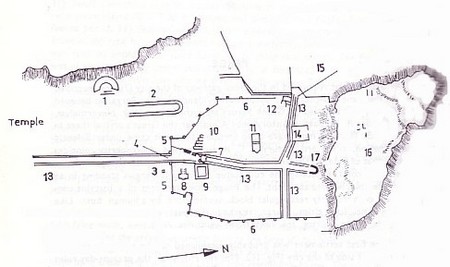
If you examine the figure above Perge ruins include:
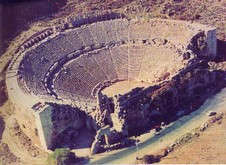 A Theatre of Greco-Roman type built against a hillside and could accomodate 15,000 spectators,
the stage erected in 2 AD was two tiered and richly decorated with reliefs representing mythological
scenes
A Theatre of Greco-Roman type built against a hillside and could accomodate 15,000 spectators,
the stage erected in 2 AD was two tiered and richly decorated with reliefs representing mythological
scenes- A Stadium probably from 2nd AD, one of the best preserved, second to that of Aphrodisias, which had a capacity of 12,000 spectators. Its monumental gate has not survived apart a few fragments. Below the seats there were 30 chambers every third of which were used for the passing of spectators and the rest served as shops bearing the shopkeepers' name in their walls.
- The Tomb of Palancia Magna, erected for a rich lady called Palancia Magna whose name occurs in over a dozen inscriptions in the city.
- The Later City Gate from the 4th cent AD
- The Later Southern City Wall built in 4th century AD and whose arch was restored by Turkish archaeologist under the supervision of Professor A.M.Mansel
- The City Wall from the Hellenistic age.Some of the towers are very well preserved and remain in almost their original height.
- The city gate complex (see next Figure)
- A Church with an eastern apse
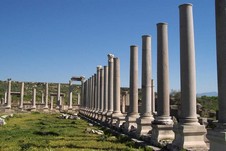 The Agora, a large square of 65 x 65 meters, built in 4th century AD when the city was enlarged,
surrounded with colonnades lined with shops and rooms.
The Agora, a large square of 65 x 65 meters, built in 4th century AD when the city was enlarged,
surrounded with colonnades lined with shops and rooms. - The Roman Baths with large windows facing southwards
- The Bishopric Basilica of Perge
- Baths
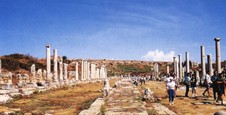 Colonnaded streets. The city was divided into four quarters by two colonnaded streets and a water
channel ran along the middle of each street.
Colonnaded streets. The city was divided into four quarters by two colonnaded streets and a water
channel ran along the middle of each street. - The Palestra, a well preserved building of 76 x 76 meters with windows overlooking the street, dedicated to Emperor Claudius (AD 41-45)
- Street lined with tombs
- The Acropolis on the eastern flat hill probably the site of the original settlement.
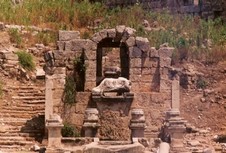 Nymphaion or fountain from the period of the Emperor Hadrian. It is a statue laying on a base and
water flows directly below the statue into the channel that ran in the colonnaded street north to south.
Nymphaion or fountain from the period of the Emperor Hadrian. It is a statue laying on a base and
water flows directly below the statue into the channel that ran in the colonnaded street north to south.
The very famous temple of Artemis is located outside the town on the south end of the figure.
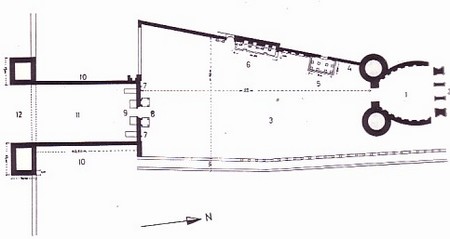
Above is the plan of the city gate complex at Perge
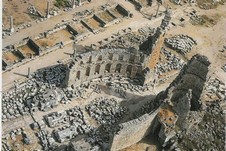 The older city gate flanked by two round towers from the Hellenistic age. It consists of a
horse-shoe-shaped courtyard and is the most impressive ruin of Perge. It was built entirely of
marble and in the niches of the upper storey of the columnar marble facade of Corinthian order
were statues of the founders of the city.
The older city gate flanked by two round towers from the Hellenistic age. It consists of a
horse-shoe-shaped courtyard and is the most impressive ruin of Perge. It was built entirely of
marble and in the niches of the upper storey of the columnar marble facade of Corinthian order
were statues of the founders of the city.- A Two Tiered Gateway with three doorways with the niches containing statues of Roman emperors and empresses
- The 92 meters long Large Courtyard
- Here in the three niches three statues were discovered, probably one of Plancia Magna. These and all the other statues discovered are now in Antalya museum.
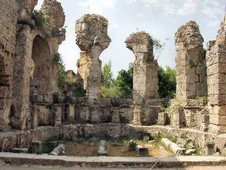 The Propylon or gates that were used to enter the Roman baths
The Propylon or gates that were used to enter the Roman baths- The Nymphaion or fountain dedicated to Artemis Pergaia with statues of emperor Septimus Severus, his wife and sons, very good preserved and now in Antalya museum.
- The south wall with niches and decorations
- The gateway erected by emperor Septimus Severus
- The large bases supporting a columnar facade
- City walls
- A rectangular courtyard
- The Outer Gate
March 31, 2009
